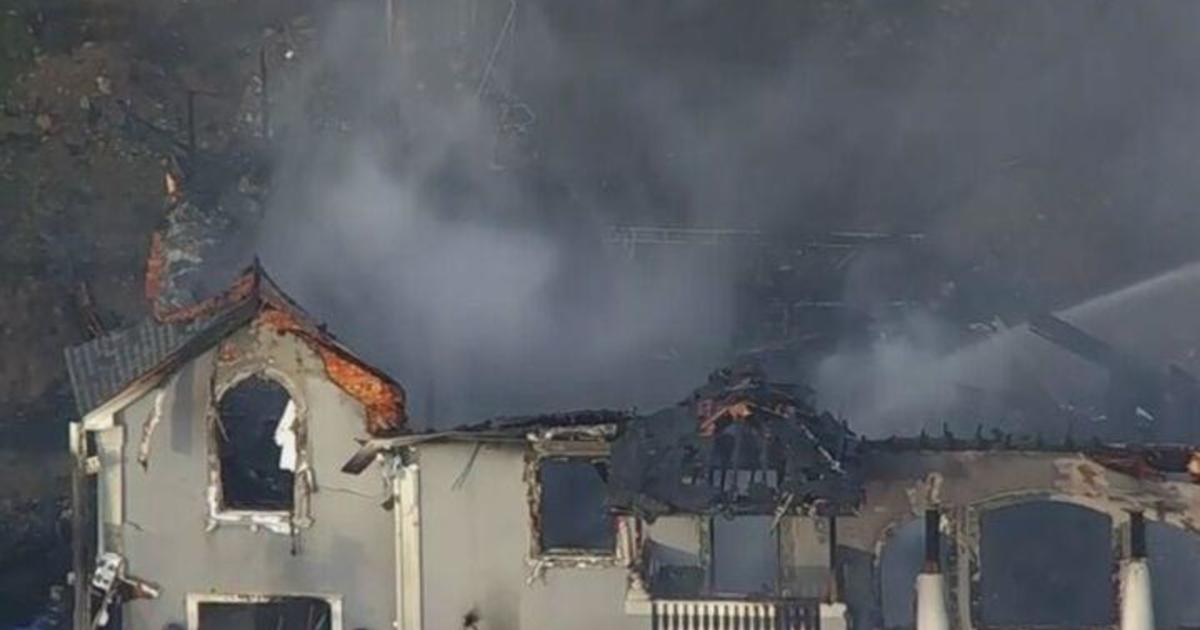Federal Report: Climate Change Is Upon Us
WASHINGTON (CBSNewYork/AP) - Climate change is a very real problem, according to a new federal report called the National Climate Assessment.
Global warming is rapidly turning America the beautiful into America the stormy, sneezy and dangerous, according to a new federal scientific report. And those shining seas? Rising and costly, the report says.
Indeed, climate change's assorted harms "are expected to become increasingly disruptive across the nation throughout this century and beyond,'' the National Climate Assessment concluded Tuesday. The report emphasizes that warming and all-too-wild weather are changing daily lives, using the phrase "climate disruption'' as another way of saying global warming.
As CBS 2's Elise Finch reported Tuesday, the report advised that Americans should get ready for more extreme weather of all kinds – including superstorms, hurricanes, immobilizing snowstorms, heat waves and damaging floods.
"Areas of the country that are already quite hot are going to get hotter," said Dr. Kathryn Sullivan of the National Oceanic and Atmospheric Administration. "Already, wet places getting wetter. Already, dry places getting dryer."
Still, it's not too late to prevent the worst of climate change, says the 840-page report, which the White House is highlighting as it tries to jump-start often-stalled efforts to curb heat-trapping gases. "It's a good news story about the many opportunities to take cost-effective actions to reduce the damage,'' said White House science adviser John Holdren.
WEB EXTRA: Read The Full Report (pdf)
Holdren called the report, the third edition of a congressionally mandated study, "the loudest and clearest alarm bell to date signaling the need to take urgent action.'' Later this summer, the Obama administration plans to propose new and controversial regulations restricting gases that come from existing coal-fired power plants.
President Barack Obama himself commented on the issue Tuesday.
"If temperatures are rising, you're going to see more extreme weather events -- and that means that more people are at risk, more homes are lost, more lives are potentially lost," Obama said. "It's going to impact people in severe significant ways that cost money."
The 840-page report assessed weather events by region, and found that between 1895 and 2011, temperatures in the Northeast increased by almost 2 degrees. The report said coastal flooding in the Northeast has increased due to rise in sea level, precipitation has increased by 5 inches.
The report says the intensity, frequency and duration of the strongest Atlantic hurricanes have increased since the early 1980s, but it is still uncertain how much of that is from man-made warming. Winter storms have increased in frequency and intensity and have shifted northward since the 1950s, it says. Also, heavy downpours are increasing - by 71 percent in the Northeast. Heat waves, such as those in Texas in 2011 and the Midwest in 2012, are projected to intensify nationwide. Droughts in the Southwest are expected to get stronger. Sea level has risen 8 inches since 1880 and is projected to rise between 1 foot and 4 feet by the year 2100.
Environmental groups praised the report. "If we don't slam the brakes on the carbon pollution driving climate change, we're dooming ourselves and our children to more intense heat waves, destructive floods and storms and surging sea levels,'' said Frances Beinecke, president of the Natural Resources Defense Council.
Scientists and the White House called it the most detailed and U.S.-focused scientific report on global warming.
"Climate change, once considered an issue for a distant future, has moved firmly into the present,'' the report says. "Corn producers in Iowa, oyster growers in Washington state and maple syrup producers in Vermont are all observing climate-related changes that are outside of recent experience.''
The report looks at regional and state-level effects of global warming, compared with recent reports from the United Nations that lumped all of North America together.
"All Americans will find things that matter to them in this report,'' said scientist Jerry Melillo of the Marine Biological Laboratory, who chaired the science committee that wrote the report. "For decades we've been collecting the dots about climate change, now we're connecting those dots.''
Some New Yorkers on Tuesday also said the report should be a wake-up call.
"It's a badly needed reality check," said Melvin Jones of Bushwick. "It's an issue that must be faced and dealt with."
"It's important," said Lisa Ridenhour of Roosevelt, Long Island. "It's saving our lives. It's saving our earth."
"This is a global problem," said Sam Kingsley of the Upper West Side. "We can't solve it on our own, and it's up to the president to make the country recognize that."
"I hope that President Obama's actions do spark a change, but we've known about this for a while, and if we wanted to make a change, we would have already," said Lizzie Benzik of Morningside Heights.
Obama said efforts have been taken to combat climate change – but they are not enough.
"We've already increased our production of solar and wind power. We've already increased fuel efficiency standards on cars, and we're going to appliances," he said. "But we have to do more."
In a White House conference call with reporters, National Climatic Data Center Director Tom Karl said his two biggest concerns were flooding from sea level rise on the U.S. coastlines - especially for the low-lying cities of Miami; Norfolk, Virginia; and Portsmouth, New Hampshire - and drought, heat waves and prolonged fire seasons in the Southwest.
Karl also highlighted the increase in downpours, which are jumping by 30 percent to 60 percent elsewhere in the country besides the Northeast. He said last week's drenching, when Pensacola, Florida, got up to two feet of rain in one storm and parts of the East had three inches in one day, is what he's talking about.
"The projections for these kinds of changes are to continue as the globe continues to warm and the atmosphere is able to hold more water vapor,'' Karl said.
Meanwhile, since January 2010, 43 of the contiguous 48 states have set at least one monthly record for heat, such as California having its warmest January on record this year. In the past 51 months, states have set 80 monthly records for heat, 33 records for being too wet, 12 for lack of rain and just three for cold, according to an Associated Press analysis of federal weather records.
The report also says "climate change threatens human health and well-being in many ways.'' Those include smoke-filled air from wildfires, smoggy air from pollution, and more diseases from tainted food, water, mosquitoes and ticks. And ragweed pollen season has lengthened.
Flooding alone may cost $325 billion by the year 2100 in one of the worst-case scenarios, with $130 billion of that in Florida, the report says. Already the droughts and heat waves of 2011 and 2012 added about $10 billion to farm costs, the report says.
The report urged a global reduction in the use of oil, gas and coal. But some energy experts said such measures will not help.
"We have spent a trillion dollars -- we'll spend trillions more -- to accomplish essentially nothing," said Mark Mills of the Manhattan Institute for Policy Research. "To make a big difference in energy fields, we need fundamental research to find very different ways on how to make energy at prices the world can afford at the quantities the world needs and that just doesn't exist yet."
Meanwhile, some fossil energy groups, conservative think tanks and Republican senators immediately assailed the report as "alarmist.''
U.S. Senate Republican leader Mitch McConnell (R-Ky.) said President Barack Obama was likely to "use the platform to renew his call for a national energy tax. And I'm sure he'll get loud cheers from liberal elites - from the kind of people who leave a giant carbon footprint and then lecture everybody else about low-flow toilets.''
Sen. David Vitter (R-La.) said the report was supposed to be scientific but "it's more of a political one used to justify government overreach.''
The report - which is full of figures, charts and other research-generated graphics - includes 3,096 footnotes to other mostly peer-reviewed research. It was written by more than 250 scientists and government officials, starting in 2012.
A draft was released in January 2013, but this version has been reviewed by more scientists, including twice by the National Academy of Science which called it "reasonable,'' and has had public comment. It is written in a bit more simple language so people can realize "that there's a new source of risk in their lives,'' said lead author Gary Yohe of Wesleyan University in Connecticut.
You May Also Be Interested In These Stories
(TM and © Copyright 2014 CBS Radio Inc. and its relevant subsidiaries. CBS RADIO and EYE Logo TM and Copyright 2014 CBS Broadcasting Inc. Used under license. All Rights Reserved. This material may not be published, broadcast, rewritten, or redistributed. The Associated Press contributed to this report.)



